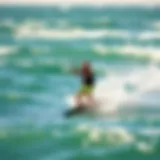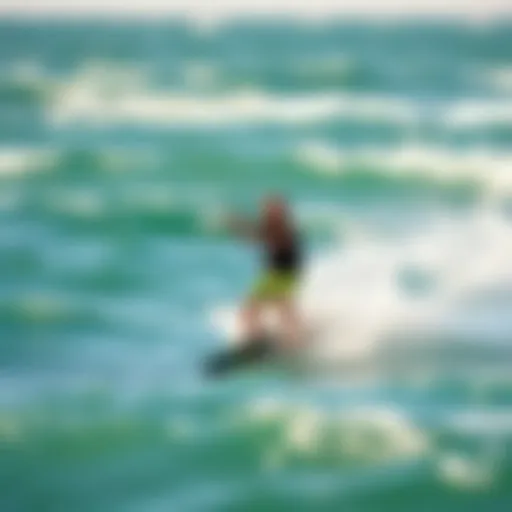Exploring the Exciting World of Wing Kitesurfing
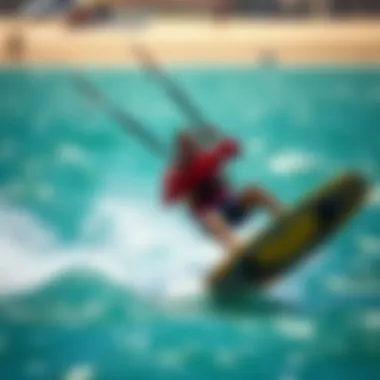
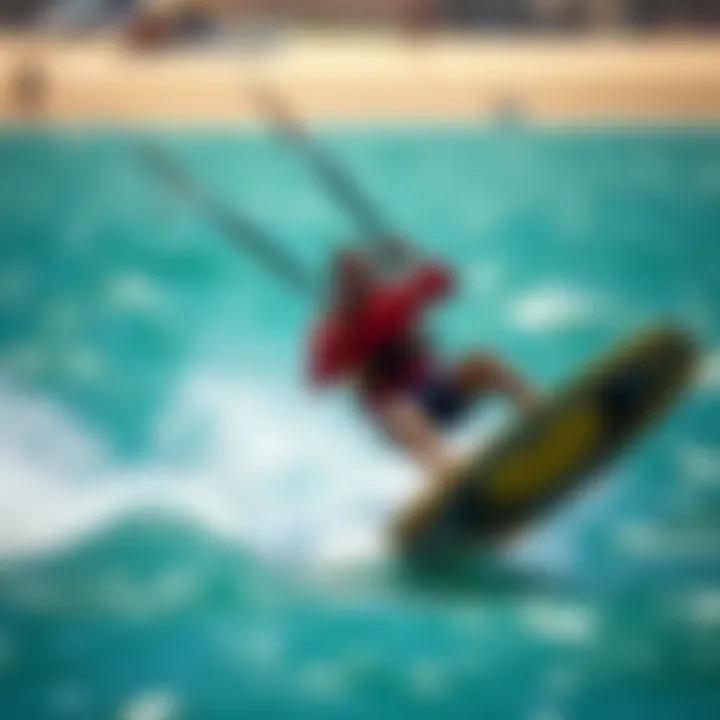
Intro
Wing kitesurfing is carving its niche in the vast ocean of water sports. Imagine gliding over waves, harnessing the wind, effortless balance between gravity and lift. It’s a sight to behold and a joy to experience. As this sport takes off, it attracts a diverse crowd, from seasoned kiteboarders searching for the next thrill to newcomers eager to ride the wind.
This article lays out the essentials surrounding wing kitesurfing, dipping into its origins, equipment must-haves, techniques to hone, and safety practices to consider. Each element plays a crucial role not just in mastering the sport but in deeply connecting with the growing community that thrives on the shores.
So, whether you’re plotting your first foray into wing kitesurfing or looking to solidify your existing skills, let’s dive into the nuances that make this sport both captivating and rewarding.
Gear Insights
Latest Gear Reviews
When it comes to wing kitesurfing, the right gear makes a world of difference. Take, for instance, the Duotone Wing. With its lightweight design and responsive handling, it’s popular among enthusiasts who want a tool that can respond instantly to their commands. Another standout is the Naish Wingsurfer, boasting excellent durability and performance, perfect for both light and strong wind conditions.
The foils also deserve a shoutout. The Slingshot Phantasm foils typically receive high praise for their stability and speed, making them an ideal choice for those wanting to push their limits. However, don’t overlook the importance of comfort; harnesses like the Mystic Stealth can enhance your experience by providing the support needed for longer rides.
Essential Gear for Beginners
For those just setting foot into this world, the gear selection can be intimidating. Here’s a straightforward rundown:
- Wing: Start with a moderate-sized wing, usually between 4-6 meters for comfortable handling.
- Board: A wider board offers better stability for newcomers, helping to build confidence.
- Foil Setup: Consider a beginner-friendly foil that can help you lift off with less effort.
- Safety Gear: A good impact vest and a helmet are no brainers! Your safety is paramount.
Each piece of equipment works in harmony to create an exhilarating experience. Make sure to test several options, if possible, before settling on the gear that fits your style and comfort.
"The right gear doesn’t just enhance performance; it breeds confidence. Approach wing kitesurfing ready, and you open your world to endless possibilities."
Techniques and Tips
As you evolve in wing kitesurfing, learning various techniques becomes key. Begin with the basics, like standing up with control and mastering your balance on the board. Once the foundational elements are down, you can start exploring advanced tricks.
Advanced Tricks and Techniques
Something exciting about this sport is its dynamic nature. Here are a few tricks that can spice up your sessions:
- Jumps: Timing your wing's lift with your board’s pop can elevate your experience – literally!
- Tacks: Master your tacks for efficient direction changes while maintaining speed.
- Downwind Gliding: A thrilling way to twist and turn across the surface while utilizing the wind efficiently.
Practice makes perfect, and with regular sessions, you’ll soon find these tricks adopting to become second nature.
Safety Practices for Kiteboarders
While the allure of wing kitesurfing is irresistible, safety cannot be overstated. Here’s what to bear in mind:
- Awareness: Always be pickin’ up on weather conditions before hitting the water. Wind can be fickle.
- Check Your Gear: Pre-flight checks can save you from a world of trouble. Inspect everything, from wings to foils.
- Know Your Limits: Don’t bite off more than you can chew. Gradually push your boundaries, respecting your skill level.
Overall, wing kitesurfing offers a blend of thrill and tranquility. The gear, the techniques, and safety measures come together to create a vibrant yet safe environment that keeps enthusiasts coming back for more.
Preface to Wing Kitesurfing
The world of wing kitesurfing has opened up a fresh avenue for thrill-seekers and water enthusiasts alike. This sport intertwines cutting-edge technology with the age-old joy of gliding over water, making it both innovative and accessible. The significance of wing kitesurfing is not just about the adrenaline rush it provides; it also introduces various benefits that are crucial for beginners and seasoned adventurers. Moreover, understanding its context helps in appreciating how far water sports have progressed.
Historical Context and Evolution
Wing kitesurfing is a relatively new player in the realm of water sports. Its roots can be traced to traditional kitesurfing, where surfers used large kites to harness the wind while riding on a board. However, what set wing kitesurfing apart was the introduction of a handheld wing. This new design allowed for greater control and easier navigation, especially in varied wind conditions.
The first wing designs became available in the early 2010s. They were rudimentary compared to today's sophisticated models but paved the way for innovation. As manufacturers experimented with various materials and designs, the efficiency and performance of wings improved substantially. The sport began to gain traction among enthusiasts, leading to a growing community and an increasing number of events.
Consequently, as technology advanced, the wings evolved to feature lightweight materials and enhanced aerodynamics. This evolution has made wing kitesurfing more enjoyable, attracting a diverse group of practitioners, including those who might have never considered kitesurfing before. Today, the sport enjoys a global following, boasting vibrant communities on social media platforms like Reddit and international competitions that showcase skills and innovations.
Defining Wing Kitesurfing
Wing kitesurfing, at its core, is about maneuvering a floating board while pulling a wing through the wind. Instead of having a kite attached to the rider, the wing is held independently, allowing for freedom of movement that is quite distinct. Riders can easily change direction, perform tricks, and ride on various types of water surfaces, including lakes, rivers, and oceans.
This sport is particularly appealing because it combines elements of surfing, windsurfing, and kitesurfing into a single thrilling experience. The minimal setup required makes it accessible, even for those who are just starting, and allows for easier transportation compared to traditional kitesurfing setups. An added charm is that you don’t have to be tethered to a specific launch area. Instead, the versatility of wing kitesurfing enables riders to launch from various spots, making every session feel unique.
Understanding the Equipment
To engage fully with the exhilarating realm of wing kitesurfing, grasping the intricacies of the equipment used is pivotal. Understanding the equipment provides essential insights into how different components function together to enhance performance and safety on the water. Each element, from wings to boards, plays a significant role, influencing how riders interact with the wind and water, thus ensuring a fluid and enjoyable experience. The right gear not only aids beginners in finding their footing but also allows seasoned veterans to push their limits and explore advanced maneuvers.
Wings: Types and Specifications
When delving into wings for kitesurfing, it's essential to note that there are varied types tailored for distinct conditions and rider preferences. The wings can be classified primarily into inflatable wings and rigid wings. Inflatable wings are favored for their lightweight nature and versatility, making them ideal for beginners who might appreciate the forgiving nature of the inflatable design. Rigid wings, on the other hand, boast efficiency and stability in higher winds, offering seasoned riders the precision they crave while executing tricks.
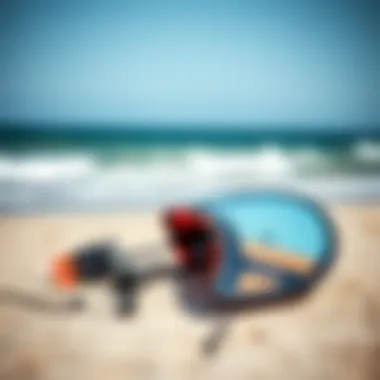
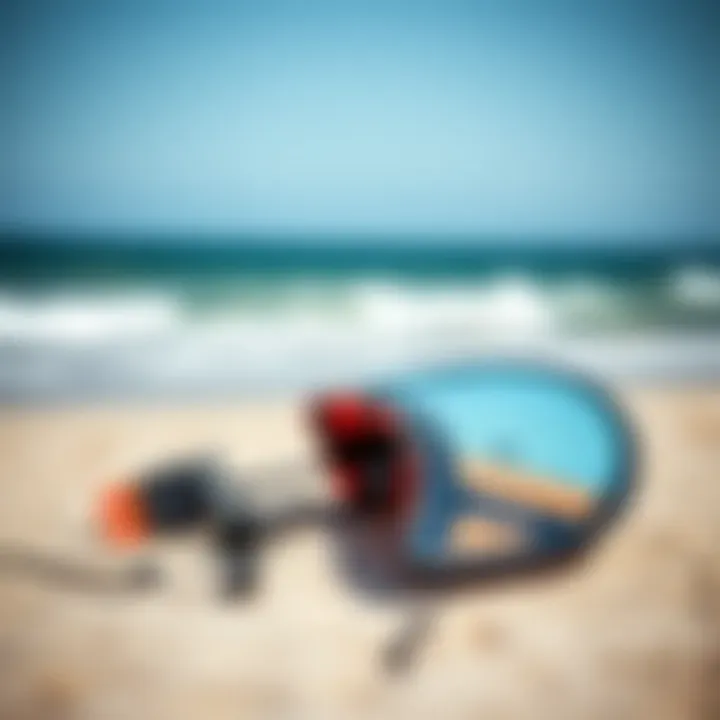
Some important specifications to consider include:
- Size: Measured in meters squared, the wing size determines how much power a rider can harness from the wind. Generally, beginners might opt for larger wings which offer more power at lower wind speeds, while experienced riders may choose smaller wings for higher winds.
- Aspect Ratio: This refers to the width of the wing relative to its height. A higher aspect ratio typically translates to better upwind performance and speed, appealing to more experienced kitesurfers.
- Materials: The fabric used can impact durability and performance. Youth riders might lean towards wings made from tougher materials that withstand wear, while those at professional level may prioritize lightweight materials that enhance speed.
In summary, understanding the types and specifications of wings not only empowers riders to make informed choices but also equips them for a safer and more exhilarating adventure on the water.
Boards: Choosing the Right Design
A board serves as the foundation of the kitesurfing experience. Choosing the right design hinges heavily on personal style, skill level, and typical riding conditions. Each board exemplifies unique qualities, and the selection is often a reflection of the rider's intended maneuvers.
Some of the primary considerations when selecting a board are:
- Size and Shape: A larger board offers more stability and is therefore suitable for beginners. Conversely, smaller boards are designed for speed and agile maneuvers, catering to more advanced riders.
- Material: Boards typically come in various materials, such as foam or composite. Foam boards are often recommended for newcomers due to their buoyancy and forgiving nature, while composite boards provide enhanced performance for those looking to push their boundaries.
- Foot Straps and Pads: The connection between rider and board must be secure yet comfortable. The choice of straps is essential, as they impact the rider's ability to maneuver and perform tricks.
When it comes to boards, every rider will find a unique fit that resonates with their style. Whether you enjoy smooth glides or sharp turns, the right board design will enable you to carve your path on the water with confidence.
Safety Gear Essentials
In every adventurous activity, safety should always take precedence, and wing kitesurfing is no different. Using the appropriate safety gear is crucial for ensuring both personal safety and the well-being of fellow water enthusiasts.
Key pieces of safety gear include:
- Personal Flotation Device (PFD): A high-quality PFD is non-negotiable. Look for one that suits your body type while allowing for manageable movement.
- Helmet: A helmet shields your head from potential impacts. It is especially important in crowded areas or when attempting advanced tricks.
- Impact Vest: An impact vest acts as additional protection against hard landings and offers buoyancy for those still finding their balance.
- Leash: A leash prevents the wing from drifting away in case you fall, ensuring it remains within reach while you regain your stance.
- Safety Release Mechanism: Familiarity with your gear’s safety release mechanism is vital, providing a quick method to disconnect during emergencies.
Incorporating safety gear into your regularly used equipment not only lends reassurance but also boosts confidence in challenging conditions. Grasping the importance of safety is essential for any kitesurfer hoping to enjoy the adrenaline rush that wing kitesurfing brings.
Fundamental Techniques
Understanding the fundamental techniques of wing kitesurfing is essential for anyone looking to master the sport. These techniques not only enhance your performance on the water but also ensure safety and sustained enjoyment. Learning the ropes can help kitesurfers avoid common pitfalls and progress more effectively. Mastering these skills sets a strong foundation for making the most of wing kitesurfing, whether you’re a novice or an experienced rider.
Starting and Stopping
Starting and stopping are two of the most critical techniques to learn in wing kitesurfing. When you're out there on the water, you want to get up and moving quickly, and knowing how to launch your wing efficiently can make all the difference.
To start, it’s all about mastering the initial stance. Position your board correctly while holding the wing at about a 45-degree angle to catch the wind. Once you feel the lift, lean forward, and use your legs to push off the water. This technique is about finding that sweet spot between balance and speed. With practice, you should be able to take off smoothly and gracefully.
Stopping, on the other hand, is about more than just hitting the brakes. The goal is to transition from speed to stability without belly-flopping into the water. Shift your weight back gently and let the wing fall to your side. This maneuver will slow you down naturally and allow for a controlled stop without sending you sprawling. Remember, practice makes perfect, and over time, you will find what works best for you.
Control and Steering Mechanisms
Control is paramount when it comes to wing kitesurfing. It's one thing to ride a board but quite another to navigate effectively. Your wing serves as both sail and steering wheel, and learning how to maneuver it can significantly enhance performance.
Understanding the way the wing responds to your inputs is crucial.
- Pressure Management: By adjusting the pressure on the wing through body positioning, you can change your speed and direction. Leaning forward accelerates, while sitting back eases off the throttle.
- Directional Steer: You’ll need to steer using both the wing’s trailing edge and your body weight. Pulling on one side of the wing while shifting your weight in the opposite direction helps in turning smoothly.
Taking the time to drill these steering techniques will pay off in the long run, allowing for sharp turns and smooth transitions.
Transitioning and Maneuvering
Transitioning refers to changing directions without losing speed or control. It’s not as daunting as it may sound if you break it down into manageable pieces. As you come up to a turn, begin by shifting your weight and turning the wing across your body. The main trick here is to keep your movements fluid and continuous to avoid the dreaded stalling.
- Initiate the Turn: Shift weight onto your back foot while tilting your body towards the direction you want to go.
- Wing Control: Move the wing from one side to the other in a smooth arc. Keeping the wing depowered during the turn is essential to maintain grip.
- Smooth Exit: As you come out of the turn, re-engage the wing and smoothly transfer your weight forward again.
Effective maneuvering is a blend of body positioning and wing manipulation. With practice, these transitions can become second nature, allowing riders to gracefully cruise the water and impress onlookers.
Advanced Techniques for Experienced Riders
Once you’ve mastered the fundamentals, the time comes to elevate your skills with some advanced techniques. These maneuvers are the ones that can really make you shine on the water.
- Jumping: If you're looking to get airborne, understanding the timing of the pop is key. It's about pulling on the wing when you’re ready to unleash that power.
- Downwinders: This technique involves riding up the wind and turning around to ride downwind, which allows for some elegant, flowing rides. Timing your turns and keeping your momentum is crucial.
- Freestyle: This is where creativity comes into play. Adding spins, flips, or even simple tricks can enhance your style and stoke your passion for the sport.
Learning these advanced techniques involves risk, so keep safety in mind. It’s wise to practice in suitable conditions and ensure you’re surrounded by competent riders.
Mastering the fundamental techniques of wing kitesurfing not only enhances your abilities but also builds the confidence needed to explore the thrilling side of the sport.
By focusing on these techniques, you can pave the way for personal growth and enjoy the wide, exhilarating world that is wing kitesurfing. Whether you are just starting or looking to advance your skills, these foundational elements will lead you to a more rewarding experience on the water.
Safety Considerations
Safety is paramount when it comes to wing kitesurfing. Both the thrill and risk associated with this sport mean that understanding safety considerations is not just advisable; it’s essential. A moment's lapse can lead to unintended consequences, potentially endangering not just yourself but also others enjoying the water. Let’s delve into key facets of safety to ensure you ride the waves with confidence.
Understanding Wind Conditions
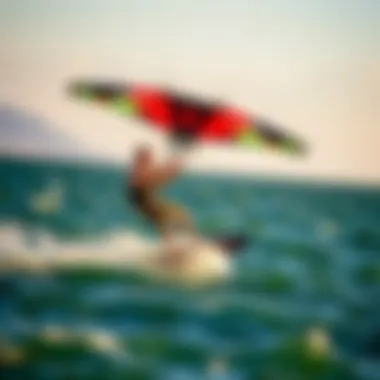
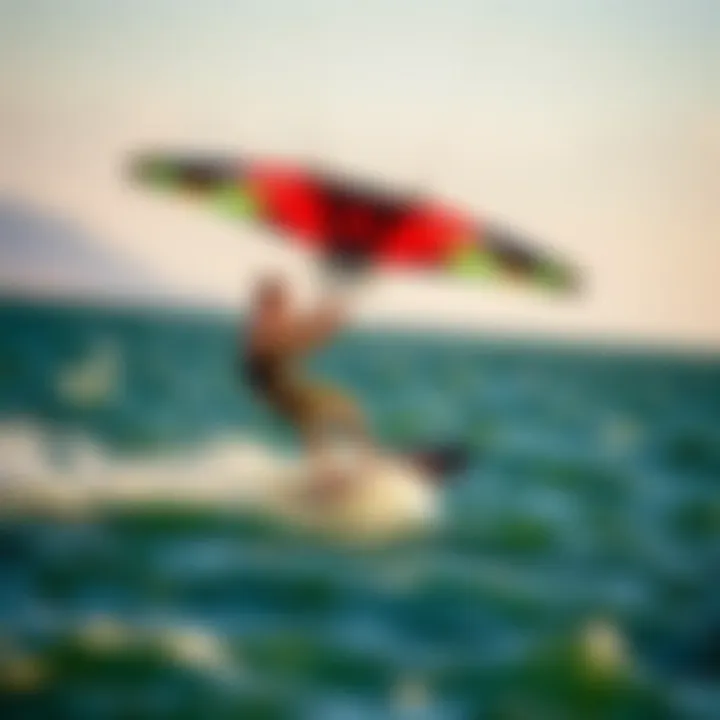
Wind conditions are the lifeblood of wing kitesurfing, and knowing how to read them is crucial. For starters, you want to pay attention to wind speed and direction, as these factors greatly influence your performance on the water. Generally, breezes between 12 to 20 knots are ideal for most riders, but this can vary based on your skill level and the equipment you are using.
- Anemometers can help measure wind speed accurately.
- Consider local forecast services for real-time data.
If winds consistently exceed 25 knots, it’s advisable to stay on shore or choose lighter gear. Confident as you may feel, high winds can make controlling the wing much more challenging and increase the risk of accidents.
When assessing wind direction, you should look out for shifting patterns. For instance, a sudden gust coming from behind can catch an unsuspecting rider off guard. Familiarize yourself with the local geography; wind can behave differently in different locations due to factors like terrain and buildings.
"Understanding the wind is like reading the waves of opportunity – miss it, and you’ll wipe out."
Recognizing and Avoiding Hazards
Hazards on the water are like pesky flies at a summer picnic; you can’t always see them until it’s too late. A keen surfer should be vigilant about potential risks. These include:
- Obstacles: Buoys, rocks, or swimming areas should be mapped in your mind. Don’t just rely on instinct; plan your route before taking off.
- Other Surfers: While camaraderie is a part of the sport, ensuring a safe distance from other riders is imperative. Collisions can lead to injuries, both for you and them.
- Changing Water Depth: As you cruise along, be wary of shallower areas that might surprise you. Skimming over hidden rocks or coral can lead to disastrous falls.
- Marine Life: Being aware of your surroundings includes keeping an eye out for creatures like jellyfish, which can be harmful if you’re stung.
You might consider practicing in a spot with lifeguard supervision or amongst fellow enthusiasts. That way, you have a buffer against unexpected circumstances.
Emergency Procedures
No one likes to think about emergencies, yet they are a part of any outdoor sport. In wing kitesurfing, having a set plan can make all the difference when it counts.
- Know Your Area: Understand where the nearest help can be found—whether it's a lifeguard station or a buddy on the beach. Familiarize yourself with emergency numbers for local authorities.
- Communication: Carry a whistle or a small waterproof phone pouch to stay in touch with others. Hand signals can also help relay your needs without unnecessary panic.
- Self-Rescue Techniques: Learn how to perform self-rescue maneuvers. If you find yourself in uncharted waters or in trouble, these skills can buy you time until help arrives.
- Buddy System: Whenever possible, don’t ride solo! Having a friend on standby can not only enrich the experience but could be life-saving in urgent situations.
In a nutshell, wing kitesurfing is an exhilarating experience. However, it’s essential to bring your safety A-game to the table. Keep your eyes peeled for wind conditions, recognize the hazards around you, and have solid emergency procedures in place. By doing so, you'll not only protect yourself but also contribute to the overall well-being of the sporting community.
The Training Process
The training process in wing kitesurfing is not just a necessity—it's a fundamental pillar that shapes the future of every rider. Engaging with an instructor and committing to a well-structured training regimen can markedly enhance both safety and enjoyment on the water. Whether you’re a complete novice or an experienced rider looking to refine your skills, understanding the nuances of training is crucial.
A solid training foundation incorporates not only essential techniques but also the psychological aspect of learning, which plays a significant role in how quickly and effectively one can progress. Having a clear training path allows riders to stay focused and sets expectations for what they can achieve over time.
"Investing in proper training is like laying a solid foundation; without it, your skills may crumble when faced with challenges on the water."
Finding the Right Instructor
Selecting the right instructor can be the difference between a rewarding experience and a frustrating one. The ideal instructor should not only have extensive knowledge but also a teaching style that resonates with you. Here are several points to keep in mind while making your choice:
- Certification and Experience: Look for instructors certified by renowned organizations such as the International Kiteboarding Organization (IKO). Years of experience on the water can also indicate their capability.
- Teaching Methodology: Different instructors have various ways of explaining concepts. Some might focus on practical skills, while others may emphasize theory. Choose one whose style best aligns with your learning preferences.
- Reputation: Read reviews or talk to other riders who have taken lessons from potential instructors. Positive feedback can give you confidence in your choice.
Making the Most of Your Instruction
Once you have found the right instructor, make sure to communicate your goals clearly. Whether you aim to master basic techniques or explore advanced maneuvers, being open about your expectations will help your instructor tailor the training to your needs.
Progression from Beginner to Advanced
The journey from a beginner to an experienced wing kitesurfer is significant and calls for a structured approach. As you gain basic skills, such as launching and landing the wing, it’s essential to gradually work towards more advanced techniques. This not only builds confidence but also ensures safety. Here’s how you might think about your progression:
- Basic Skills: Start with mastering the fundamentals, which include understanding the wind window and basic steering control.
- Intermediate Techniques: After gaining confidence, begin working on transitions and basic jumps. This might also mean practicing in varied wind conditions.
- Advanced Skills: For those looking to elevate their game, advanced techniques such as backflips or foiling require intensive practice and often additional training.
Periodical assessments of your skills can help in tracking your improvement and ensuring that you're ready before progressing to the next level. Regularly set new goals to keep your enthusiasm high.
Staying Motivated and Engaged
Maintaining motivation in wing kitesurfing can sometimes be challenging, but there are numerous strategies to keep the fire burning within. Here are some tips to stay engaged:
- Join a Local Club: Being part of a community can provide support and camaraderie. Sharing experiences with fellow kitesurfers can reignite your passion.
- Participate in Events: Compete or join in on local events. Engaging in competitions exposes you to the spirit of friendly rivalry and can boost your motivation to improve.
- Set Personal Challenges: Make goals that push your limits, whether that's learning a new trick or improving your efficiency in a specific maneuver. Setting personal benchmarks can make your training more exciting.
- Document Your Journey: Keep a journal or blog about your experiences. Reflecting on how far you’ve come can be a great motivator and an inspiring reminder of your progress.
By recognizing the importance of training and dedicating yourself to a structured learning path, you can not only enjoy wing kitesurfing but master its intricacies with confidence.
Traveling for Wing Kitesurfing
Traveling for wing kitesurfing opens up a whole new world for enthusiasts. It allows you to not just enjoy the adrenaline rush on the water, but also to explore diverse cultures and breathtaking landscapes. Wing kitesurfing isn’t just a sport; it’s an adventure. The ability to chase the wind and ride the waves can lead you to some of the most stunning spots on the planet. Whether you’re a traveler eager to share tales with fellow enthusiasts or a precise practitioner aiming for the next personal best, the right destination can make all the difference.
The multitude of locations beckons riders to experience varied conditions, which can enhance skills and enjoyment. While not every place suits every skill level, some locations are particularly favorable, each offering its own slice of paradise for wing kitesurfers. With travel, you also get the chance to connect with local communities, enrich your skill set through lessons from seasoned instructors, and maybe even find a hidden gem in the form of an isolated spot free from crowds—a kiteboarder's dream.
Moreover, planning a trip often involves considering practical aspects, such as accommodation, local regulations, or the best time of year to visit. These elements play a vital role in ensuring a smooth sailing experience.
Top Destinations for Wing Kitesurfing
When the conversation shifts to destinations, certain spots stand out regardless of your kitesurfing expertise. Here are some mentions:
- Hood River, Oregon, USA: Often touted as the mecca for kite sports, Hood River offers steady winds and a friendly vibe. Here, the Columbia River provides a perfect playground for both beginners and experts alike.
- Tarifa, Spain: Known as the wind capital of Europe, this little town features various conditions throughout the year. It’s a go-to for those looking to blend culture with kitesurfing, given its rich gastronomy and nightlife.
- Maui, Hawaii: The trade winds create fantastic conditions for kitesurfing year-round; plus, Maui’s picturesque coastlines enhance the experience. Consider visiting the north shore for stunning views and reliable winds.
- Cumbuco, Brazil: Famous for its lagoons and consistent winds, Cumbuco is a hotspot among kitesurfers who love to ride the warm waters of the Atlantic.
- Cabarete, Dominican Republic: This lively town hosts events and competitions, offering a mix of thrill-seeking and relaxation.


These spots showcase not just excellent conditions, but also communities vibrant with fellow riders.
Local Conditions to Consider
Understanding local conditions is crucial when planning your wing kitesurfing adventure. Various factors can greatly influence your experience:
- Wind Patterns: Each location has its wind characteristics. Knowing the prevalent wind direction and strength can help you time your sessions better.
- Water Conditions: Be it flatwater or waves, understanding how the local geography affects water conditions is essential. For instance, lagoons may offer calm water perfect for beginners, while some coastal spots are suited for more advanced maneuvers.
- Tide Levels: Some beaches change dramatically with the tide, impacting how and where you can ride. Always check the tides before heading out.
- Seasonal Variations: Different times of year can bring changes in wind patterns and water temperature. It’s vital to research the best seasons for each destination to get the most out of your trip.
- Local Rules and Etiquette: Being aware of local regulations and customs can save you from potential misunderstandings. Respecting the space of other riders is not only courteous but often required by local communities.
Always remember: Adaptability is key. No matter how well-planned your itinerary is, nature can surprise you.
Finding the right combination of destination and local conditions can enhance your wing kitesurfing endeavors immensely. So lace up those shoes, pack up your gear, and get ready for unforgettable experiences that await on the horizon.
Community and Culture
Community and culture play a pivotal role in the ever-evolving sports world, and wing kitesurfing is no exception. Embracing this unique sport extends beyond the mere thrill of gliding over water; it fosters connections among enthusiasts who share a deep appreciation for adventure, nature, and skill. This section elaborates on the significance of community and culture in wing kitesurfing, underlining its benefits, elements, and considerations.
Connecting with Other Enthusiasts
Finding others who share a passion for wing kitesurfing can be a rewarding experience. There’s nothing like the camaraderie formed between riders who share tips, tricks, and tales from their adventures on the water.
- Meetups and Local Clubs: Many regions have clubs that host regular meetups. These gatherings often include equipment swaps and demo days, allowing new riders to try various wings and boards.
- Skill Sharing: Experienced riders are usually keen to assist beginners. From advice on technique to suggestions on gear, community members help one another improve. It’s a two-way street, often filled with laughter and learning.
- Events and Competitions: Local competitions or festivals serve as a platform for connecting with other enthusiasts. Not only do these events showcase talent, but they also bring together individuals who might not cross paths otherwise.
When trying to link up with fellow riders, leveraging social media can help tremendously. Creating a buzz around local events on platforms like Facebook or Instagram can often increase attendance, creating a more vibrant community.
Online Communities and Resources
The digital realm complements face-to-face interactions, giving rise to diverse online communities focused on wing kitesurfing. For those unable to connect locally, virtual groups provide a great way to engage and learn from enthusiasts worldwide.
- Forums and Discussion Boards: Websites like Reddit offer subreddits dedicated to kitesurfing. Here, users post questions, share their experiences, and discuss the latest gear trends. It’s a treasure trove of information where insight from various skill levels and locations converge.
- Social Media Groups: Platforms like Facebook and Instagram have numerous groups where members can share videos, photos, and advice. Such platforms foster a friendly exchange where riders can show off their skills or seek assistance from seasoned veterans.
- Resource Hubs: Several dedicated websites compile valuable information ranging from guides and tutorials to safety tips. Websites like en.wikipedia.org provide broad overviews, while specialized blogs dive deep into niche subjects.
"Connecting through shared passions amid breathtaking coastlines elevates wing kitesurfing into something far greater than a sport. It becomes a lifelong experience shaped by friendships, adventures, and the thrill of being part of a vibrant community."
Engaging with these online resources not only broadens knowledge but also enriches the overall experience of wing kitesurfing. As the community grows, the collective culture develops deeper roots, making the sport more enriching for everyone involved.
Future of Wing Kitesurfing
The realm of wing kitesurfing is on the brink of transformation, fueled by innovations and shifts in cultural perceptions. As more individuals dip their toes into this exhilarating discipline, the future looks promising yet unpredictable. This segment addresses the vital elements shaping the upcoming landscape of wing kitesurfing, demonstrating its significance not just for enthusiasts, but for the industry at large.
Consider the impact of technology on the sport. Equipment advancements such as lighter materials and improved designs have already made wings more maneuverable and engaging. For example, new hybrid wings are hitting the market, combining features from both kites and traditional wings, leading to better performance under various wind conditions. These innovations don't just enhance the experience for seasoned riders; they also make the sport more accessible for newcomers longing for that first taste of adventure.
Furthermore, the increased focus on environmental sustainability can’t be overstated either. Manufacturers are gearing up to produce eco-friendly materials, which might draw in a new audience that values environmental consciousness while enjoying thrilling water sports.
"Innovation isn’t just about making something new; it’s about enhancing the experience of the riders and preserving the integrity of the sport."
Technological Innovations
Advancements in technology have always been a double-edged sword, offering both opportunities and challenges. In wing kitesurfing, the ripple effects of technology are particularly noticeable.
- Materials: Lighter and stronger materials, like ripstop nylon or specific composites, have emerged. They offer better durability while reducing the weight, allowing riders to experience less strain while executing tricks.
- Inflatable Technology: Innovations in inflatable wings promise to create more stable flight conditions and easier handling in diverse winds, thereby expanding usability across varying experience levels.
- Smart Devices: There’s also the introduction of smart gadgets that connect with your gear. They can provide real-time information about wind speeds and ocean currents, enabling riders to optimize their performance.
- Safety Enhancements: Safety mechanisms are evolving as well. New leash systems or integrated flotation devices ensure that even in challenging conditions, riders maintain higher safety standards, reducing the risk of accidents.
All these innovations resonate with enthusiasts eager for continuous progress and an enhanced riding experience.
Predictions and Trends
Looking ahead, several trends are likely to emerge within wing kitesurfing, reflecting not only the developments in technology but also shifts in community interests.
- Wider Adoption Among Various Age Groups: As more families take to the water, wings are likely to appeal to younger generations and older riders alike. The trend leans away from extreme sports becoming overly niche as inclusivity makes its mark.
- Growth in Community Events: Expect an increase in meet-ups, competitions, and festivals. These events can foster camaraderie among riders and also provide learning platforms for newcomers.
- Focus on Sustainability: Consumers are showing a preference for sustainable practices, which could lead to more significant industry shifts toward eco-friendly materials and responsible manufacturing processes.
- Investment in Training Programs: As people increasingly look towards this sport, demand for structured training programs will likely spike. Schools and instructors will need to adapt, offering lessons to novice riders eager to partake in this burgeoning sport.
- Integration of Other Sports: We might witness the fusion of wing kitesurfing with kiteboarding, foiling, and other water sports, creating new hybrid styles that could attract a broader audience.
In short, the future of wing kitesurfing is unfolding before us, marked by a blend of technological improvements, community expansion, and ecological consciousness. Those prepared to engage meaningfully with these trends will undoubtedly find their place in this dynamic and exciting world.
For further reading on trends in water sports, check out Wikipedia or join discussions on platforms like Reddit for a deeper dive into community insights.
End
In wrapping up our exploration of wing kitesurfing, it’s clear that this thrilling sport encapsulates much more than just riding the waves. The importance of this sport cannot be overstated, as it continually evolves with changing technology and growing communities.
Reflecting on the Experiences
Reflecting on the diverse experiences of riders, one can see that every session on the water holds unique stories. From a beginner struggling to stay upright to an advanced rider perfecting a jump, each moment contributes to personal growth and collective camaraderie. These experiences, whether grand or minute, shape the way individuals bond over a shared passion. Whether sharing a laugh after a tumble or celebrating a first successful ride, the emotional tapestry woven through these shared moments creates a lasting impact on one's life.
This shared journey fosters a sense of belonging, making riders part of a larger narrative that transcends geographical boundaries. As one becomes more involved in the sport, there’s a natural inclination to support and encourage fellow enthusiasts, amplifying the culture and spirit that breathe life into wing kitesurfing.
Encouragement for Newcomers
For those standing at the precipice of this exhilarating adventure, a gentle nudge is all it takes to embark on your own wing kitesurfing journey. Start with manageable challenges that align with your skill level and gradually push your boundaries. Remember, learning curves may steep at times, but the satisfaction of overcoming obstacles is unmatched. It’s important to lean into the community—connect with instructors, join local groups, and participate in events. The warmth of shared enthusiasm creates a nurturing environment.
Even on tough days when crashing is more common than gliding, each fall brings ample opportunities for growth and learning. The thrill of catching the wind under your wing, however daunting it may seem, eventually becomes an addictive pursuit. So grab your gear, join local meet-ups, and dive into the world of wing kitesurfing. It’s a journey that promises not just physical thrill but lasting friendships and unforgettable memories.
"Adventure may hurt you, but monotony will kill you."














